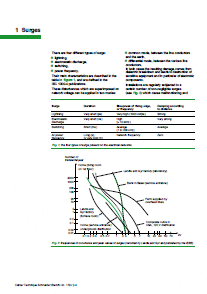Safety of equipment
Low voltage insulation co-ordination consists of matching the surge levels that may appear on an electrical network (or installation) with the surge withstand of the industrial or domestic equipment that it supplies, bearing in mind the possibility of including surge limiting devices in the network structure. This discipline contributes to increased safety of equipment and increased availability of electrical power.
Insulation co-ordination control therefore requires:
- estimation of surge level and energy,
- knowledge of the characteristics and location of the devices installed,
- selection of appropriate protection devices, bearing in mind that for a device, there is only one surge withstand (normally defined by its construction standard).
This “Cahier Technique” deals with the aspects relating to standards and implementation of disturbances, protection devices and in particular surge arresters. It mainly concerns LV installations (< 1000 V) in the industrial, tertiary and domestic sectors.
Lightning surges
Lightning is a natural phenomenon with spectacular and destructive consequences. In France two million lightning strokes cause each year the death of 40 people and 20000 animals, 15000 fires, 50000 power cuts on electrical and telephone networks and the destruction of countless transformers and thousands of electronic household appliances. The total cost of the effects of lightning is estimated at around one thousand million francs a year. Not all regions have the same degree of exposure. Although a map normally exists showing the lightning densities for each country, in order to determine in greater detail the exposure of a site, preference should be given to the maps published by firms specialising in the detection of storms and related phenomena.
Lightning is linked to the formation of storm clouds which combine with the ground to form a genuine dipole. The electrical field on the ground may then reach 20 kV/m. A leader develops between the cloud and the ground in a series of leaps, creating the ionised channel in which the return arc or lightning stroke flows.
According to the polarity of the cloud with respect to the ground, the stroke is either negative (negative cloud) or positive (positive cloud), and according to the origin of the leader, the stroke is either ascending or descending. It has been observed that in countries with a temperate climate (including France), the majority of lightning strokes are negative, but that the most energetic are positive. Their effects form the subject of two approaches: when the element studied is the one receiving the stroke, we refer to a direct lightning stroke, and when the element studied only suffers the effects of the stroke, we refer to an indirect lightning stroke. When lightning falls on a structure, the lightning current generates an impulse surge.
AUTHOR: Schneider Electric expert | Christophe SERAUDIE
| Title: | LV surges and surge arresters LV insulation co-ordination |
| Format: | |
| Size: | 0.25MB |
| Pages: | 28 |
| Download: | Right here | Video Courses | Membership | Download Updates |


